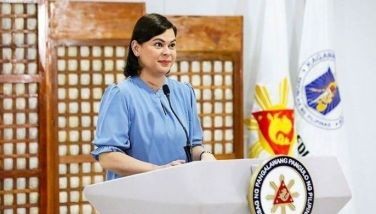Sandiganbayan on trial

It was a breath of fresh air in the world of the judiciary, which has become a center of controversy and allegations of corruption after the Ma’m Arlene scandals broke last year. I am, of course, referring to the reported recommendation of retired Supreme Court Associate Justice Angelina Sandoval-Gutierrez for the dismissal of Sandiganbayan Associate Justice and Fourth Division head Gregory S. Ong.
It was reported that Associate Justice Ong was found guilty for gross misconduct, dishonesty and impropriety. This was the result of Justice Gutierrez’s investigation of the circumstances surrounding the actions of Ong, chair of the the Sandiganbayan Fourth Division which acquitted Janet Lim Napoes in 2010 in the questionable purchase of 500 Kevlar helmets by the Philippine Marines.
For those who are not aware of the story, in 1998 allegedly using her military connections Janet Lim Napoles committed to deliver 500 Kevlar helmets to the Philippine Marines in exchange for a P3.8 million contract. I guess this was before Napoles started those billion-peso PDAF deals.
She was the actual signatory but used her mother and in-laws to put up dubious companies that participated in the bidding. The contract was awarded to 7 firms in 1998, only one of which was accredited by the Marines. The rest were either non-existent or carried residential addresses. This scheme sounds like a forerunner of the fake NGOs that were put up for the PDAF schemes.
On January 7, 1999, the Philippine Marines issued the full payment to the 7 firms for the procurement of 500 Kevlar helmets. All 14 checks were immediately encashed in Napoles’ Security Bank account in the Pasong Tamo branch.
However, Napoles did not deliver the helmets until after eight months after she was paid. She completed delivery in December 2000, more than a year later. Also, the helmets were not made in the USA as specified by the Marines but in Taiwan and were of inferior quality.
In August 2001, malversation charges were filed against the Marine officers and suppliers involved in the Kevlar deal. This included Napoles’ mother, her brother Reynaldo Luy-Lim and sister-in-law Anna Marie Dulguime. Nine years later, on October 28, 2010, the Sandiganbayan’s Fourth Division under Ong convicted the three for falsification of public documents.
However the three did not spend a single minute in jail because they applied for probation on the basis that they were not “hardened criminals who are beyond redemption.” The Sandiganbayan Fourth Division granted them probation on January 21, 2013.
Perhaps the seed for the PDAF schemes were planted during the Kevlar deals where, after 15 years, no one went to jail.
Gregory Ong is not new to controversy. He was appointed as Associate Justice of the Supreme Court of the Philippines by Gloria Macapagal Arroyo on May 16, 2007, but his appointment was subsequently withdrawn after objections arose as to his eligibility regarding the constitutionality of natural born citizenship as a requirement for Supreme Court Justices.
Since the creation of the Philippine Supreme Court in 1901, no presidential appointment of a Supreme Court Justice has ever been nullified by the Supreme Court. But on July 3, 2007, Supreme Court Associate Justice Adolf Azcuna wrote that Ong would be unable to join them on the bench “until he has proven in court that he was a natural-born Filipino citizen and corrected the records of his birth and citizenship.”
This Supreme Court voted 13-0 to uphold this judgment. The petitioners were Kilosbayan and Bantay Katarungan Foundation headed by Jovito Salonga and Ernesto Capulong.
The recent investigations against Gregory Ong were a result of the testimonies of whistleblowers Luy and Sula. Both testified, in different occasions at the Senate and the Supreme Court investigation, that Gregory Ong was the Napoles “connection” in the Sandiganbayan. It was also alleged that Ong had received monetary payments from Napoles when he visited her in Discovery offices.
When the Supreme Court meets to decide on the recommendation of Associate Justice Gutierrez, there are two corollary issues they may want to consider.
Luy and Sula have stated that Ong was a connection to the Sandiganbayan. Also the Sandiganbayan makes collegial decisions which means that it takes a unanimous vote of three justices to arrive at a decision. Therefore, can we presume that other Sandiganbayn justices colluded with Ong regarding the Napoles cases?
In fact, Ong himself said that the decision on the Kevlar case was made by the three-member division as a collegial body. Justice Gutierrez, who investigated the case, is reported to have said that she was skeptical about the Napoles acquittal case. Therefore, to what extent are the other two Associate Justices of the Fourth Division responsible for the decision?
There is also an unsubstantiated story (or rumor) going around that some Supreme Court Justices are considering merely suspending and not dismissing Gregory Ong. But if he is found guilty of dishonesty and gross misconduct, as allegedly reported by Justice Gutierrez, how can he continue to sit and judge the honesty or dishonesty of public officials? That will be the height of absurdity.
The other issue is that if Ong is found guilty of dishonesty, is he going to be tried by the Sandiganbayan?
Credit must be given to retired Supreme Court Associate Justice Angelina Sandoval-Gutierrez for taking less than six months to conclude her investigation of alleged corruption in the Sandiganbayan. This brings to mind the investigation of the Ma’m Arlene cases and alleged corruption in the judiciary. The investigative body is headed by Associate Justice Marvic Leonen who was poised to finish in six months. It is now eight months since that announcement.
Supreme Court Justice Angelina Sandoval-Gutierrez has set the standards for swift, unbiased and courageous judgments. The Sandiganbayan and the Supreme Court, who must act on her findings, are now both on trial.
* * *
Email: [email protected]
- Latest
- Trending




























